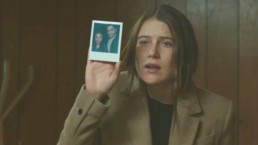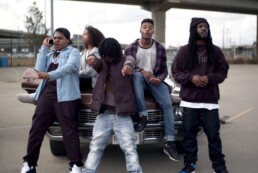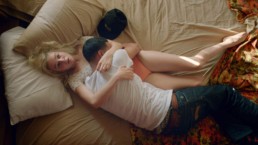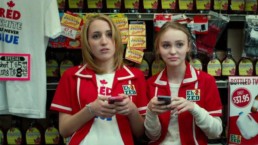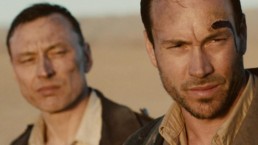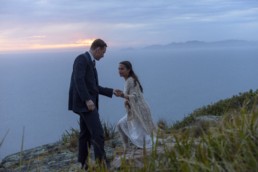'The People Garden' is a Quietly Somber and Arresting Art Film
Often times when films take place Japan, we are thrust into a bustling neon city with undeniable infectious energy- think "Lost in Translation," "Kill Bill Vol. 1," and "Black Rain" to name a few. Rarely are we given the opportunity to see the lush, green forests and wildlife that take up about 67% of the country's landscape*. Writer/director Nadia Litz captures this unspeakable beauty in her film, "The People Garden," yet turns the fairytale imagery on its head by drenching the woody oasis in mystery and death.
Sweetpea (Dree Hemingway) lands in a Japanese airport with only one small suitcase in tow, it is obvious that she is not planning on staying long. She is here to break up with her boyfriend, Jamie (François Arnaud). Jamie is on location filming a music video deep in the woods, and her calls to him go unanswered. After getting a ride from a guy named Mak (Jai West), and befriending a local girl to help her navigate through the dense forest, she finally arrives on the film set and immediately becomes very uneasy. Not only is Jamie missing, everyone seems to be hiding something. Determined to figure out what is going on, Sweetpea takes matters into her own hands.
"The People Garden" is a quietly somber yet beautiful art film that bubbles with emotion; from the beginning scenes up until the very end, we are engaged and wondering what will happen next. Starting out with a clever twist, Litz makes it clear early on that this film is not going to be predictable or straightforward by any means.
Dree Hemingway is the perfect choice for the role of Sweetpea, the way she carries herself is engaging to watch on screen (and her model looks don't hurt). She runs the full emotional gamut in the film's 80-minute runtime, from anxious to scared, daring to devastated. A rising star in the indie film circuit (her great-grandfather is Ernest Hemingway), Dree certainly proves that she deserves to be here and is more than just a famous last name.
Also returning to the screen is Pamela Anderson, who plays the role of Jamie's music video muse, Signe. She doesn't have many lines, but her performance is spot on, even slightly reminiscent of Lina Lamont from 'Singin' in the Rain.' Just the way she dangles from wires high above the forest's grounds is a breathtaking thing to see.
'The People Garden' is getting a very limited distribution, which is a shame because films like this deserve to be seen by all. Everyone who watches this film can take something away from this cinematic experience, from admiring Litz's directorial choices to lusting after Hemingway's wardrobe, do try to put 'The People Garden' on your list of under the radar, must-see movies.
* Taken from Save the World's Forests evaluation of protected and natural forests in Japan.
'The People Garden' is not rated. 80 minutes. Now playing at the Downtown Independent in Los Angeles, as well as VOD platforms.
Your First Look at Dree Hemingway in 'The People Garden' (Exclusive)
We scored an exclusive clip from director Nadia Litz's independent film, "The People Garden." When Sweetpea (Dree Hemingway) flies to Japan to break up with her rockstar boyfriend, she suddenly realizes that nothing is as it seems. Her boyfriend, Jamie, is missing, and nobody seems to be giving her a straight answer as to why. So, she takes it into her own hands to figure out what happened to Jamie.
An arresting performance from Dree Hemingway, this drama/mystery is coming to select theatres and VOD tomorrow, September 13th.
'Kicks' is a Cinderella Story for Sneakerheads
In a place where your shoes determine your status, you better believe that everyone will be doing whatever it takes to get their hands on the latest kicks.
Some will spend every last penny of their hard-earned cash on a brand new pair of shoes, while others will literally steal them off the feet of a child. It's a jungle out there in the Bay Area, or so Justin Tipping leads us to believe, in his directorial debut Kicks, an urban coming-of-age film loosely based on Tipping's experience growing up in West Oakland, where the unfairness of life seems unwavering and survival means learning how to stand up for yourself.
Brandon (Jahking Guillory) is convinced that a better pair of shoes will lead to a better life, and when he finally scores a brand new pair of rare Air Jordans, he couldn't be happier. He gets attention from girls and respect from his friends, Rico (Christopher Meyer) and Albert (Christopher Jordan Wallace–son of Notorious B.I.G.), but best of all, he escapes the reality of his impoverished life in Oakland. That is, until notorious local thug, Flaco (Kofi Siriboe), takes the shoes right off of his feet. But Brandon is not one to go down without a fight and, after enlisting his very hesitant friends, they set out to retrieve the stolen sneakers and teach Flaco a thing or two about messing with their crew.
There is no denying that Kicks will draw comparisons to other recent films, like this summer's release The Land or last year's Sundance hit Dope, but what Kicks offers in terms of variation are the surreal fever dreams that visit Brandon throughout the course of the film. His thoughts of escaping his reality and finding serenity become embodied in an astronaut that follows his character, much like a guardian angel. These pops of surreal visual effects are sprinkled throughout the film's overall hyper-naturalistic aesthetic, and the result is a beautiful achievement. Yes, all three films have killer soundtracks (Kicks enlists some heavyweight performers like Wu-Tang Clan, RJD2, and Charles Bradley) and share similar thematic threads of a young boy on a mission to get out of the ghetto. But it is the passion Brandon exudes over one pair of shoes, his only pair of shoes, that makes his story much more empathetic.
Kicks is a Cinderella story for a new generation, one in which a boy's transformation happens when he loses his shoes rather than slips his feet into them and the result is one powerful piece of work.
"Kicks" is rated R for violence, drug/alcohol use and language throughout, and sexual content - involving teens. 80 minutes. Opening in select theaters on Friday, September 9th.
Like Its Protagonist, 'White Girl' is an Alienating and Chaotic Watch
This review previously ran on August 17, 2016, during the Sundance NEXT FEST
After screening "White Girl" on the second day of the Sundance Next Fest film festival, director Elizabeth Wood sat down for a Q&A with famed director Catherine Hardwicke ("Thirteen," "Twilight") and moderator Jen Yamoto, a journalist from The Daily Beast. One of Jen's questions piqued my interest: In so many words, she asked Wood if any of the reviews had upset her – after all, "White Girl" is a very divisive film and so I would have expected Wood's answer to sound well-rehearsed and politically correct. What she responded with shocked me. She said the reviews that cast "White Girl" in an unfavorable light must have been written by men, men who are lacking in their own sexual conquests to give her film an unbiased review. Well, I'm here to say that I am a white girl, and hold the same critiques that have followed "White Girl."
"White Girl" tells the story of 18-year-old Leah (Morgan Saylor), a New York City transplant, who finds both love and trouble in gangbanger Blue (Brian 'Sene' Marc), the neighborhood drug dealer. While Leah herself is far from a virgin to the world of narcotics, falling for Blue leads her down a self-destructive path of zonked-out drug-fueled sweaty nights. When Blue gets busted for selling cocaine – his third strike – Leah naively tries to get him out of jail in any way she can, which ultimately ends up being a spiraling mess of destruction.
The association to Larry Clark's "Kids" is inescapable; whereas Clark's portrayal of impoverished NYC youth stands as a time capsule of adolescent life in the 90s, Wood's "White Girl" doesn't penetrate the thematic surface nearly deep enough to warrant essential viewing. This type of "Live Fast, Die Young" mentality that "White Girl" embodies results in a thinly felt story that tries too hard to look cool to be anything substantial. Although I have to say, the ending was the most powerful part of the entire movie, but maybe that's because it's just in those final moments when Leah finally processes her actions and the unjustifiable insanity that has just occurred.
I also just don't see how "race" plays into this film at all, a poor mark on this director's effectiveness to relay its meaning to this film. Arguably, Leah could have been of any ethnicity and the situations she found herself in would have been no different. There are no "implications of her being white or female," the only struggle she faces is when she is high out of her mind and making terrible decisions. Her interracial relationship with Blue is never seen as taboo, aside from the fact that he sells drugs, and Leah certainly doesn't act like there is any racial tension in her daily life. She has an internship at a predominately white culture & fashion magazine (along the lines of Nylon Magazine) with an attractive white boss (Justin Bartha), lives with a white roommate (India Menuez), and seeks help from a white lawyer (Chris Noth). Now the relationships she has with the above characters are not healthy ones, in fact, this is where I feel like the only social issue comes into play and that is peer pressure: pressure to snort drugs, sell drugs, and have sex. If more attention had been focused in this direction– an 18-year-old college student facing peer pressure from every which way– that would have been a more pertinent issue facing young girls today.
Yes, with its overtly explicit nature this subject matter is bold and has won fans since its Sundance debut, but unfortunately, so many of the directorial choices seemed purely for shock and awe. Other films with similar subject matter, such as "Bang Gang," and "Heaven Knows What," found a way to avoid falling under the "ostentatious" category. Elizabeth Wood has stated that "White Girl" had been a therapeutic project for her, a sort of biopic from her early college years. I'm hopeful that with this out of her system now, her next film will better utilize her voice and talents as a strong female director.
"White Girl" is not rated. 88 minutes. Opening at select Laemmle Theaters on Friday, September 9th.
Canadian-Set 'Yoga Hosers' is 'Eh'-Mazingly Absurd
One of the more wildly talked about movies from this year's Sundance Film Festival that is finally hitting theaters today is the flamboyant comedy-meets-fantasy film, "Yoga Hosers," directed by Kevin Smith. Set in a small Canadian town where the accents are as thick as maple syrup, two 15-year-old best friends, with extremely unhealthy cell phone addictions, discover that horrifying demons are taking over their workplace and threatening to ruin their late night plans. But what are these terrifying little creatures? Turns out that they're Nazi sympathizing sausages from Canada's past, appropriately called "Bratzis."
Colleen Collette (Lily-Rose Depp) and Colleen McKenzie (Harley Quinn Smith) are yoga enthusiasts by day and convenience store clerks by night. They work after school dead-end jobs at Eh-2-Zed, the local corner store that sells everything from toilet paper to "Pucky Charms" cereal. Their overall bratty attitude changes to excitement after senior heartthrob Hunter Calloway (Austin Butler) invites the girls to a totally awesome "Grade 12" party. However, things don't go according to plan when they get stuck working a late shift, and discover not only is Hunter not the sweet guy they thought he was, but that they have bigger fish to fry, or in this case, sausages. Enlisting help from Guy Lapointe (Johnny Depp), the girls are forced to defeat the meat that is threatening to kill them.
As one can safely assume by this point, "Yoga Hosers" is a wacky and wholly original moviegoing experience. The cheesiness factor is through the roof, but that is one of its biggest charms. Seeing a movie that is technically sophisticated with a top notch cast (scene stealer Ralph Garman's insanely spot-on impressions of Sylvester Stallone and Adam West draw the biggest laughs), yet one that does not take itself too seriously on screen, is a rare occurrence these days and should be recognized. Think "Bad Milo" meets "Sausage Party" in terms of the thematic guideline. However, one of my biggest critiques is how anti-climactic the ending is in comparison to the outlandish storyline. There is no stopping this crazy train and the ending could have followed through with the same emphasis.
What really makes "Yoga Hosers" great is the familial full-circle connections off-screen. Firstly, and most obviously, director Kevin Smith cast his actors close to the vest with his daughter Harley Quinn as the lead character, Colleen M. Another fun connection is between Lily-Rose Depp, who not only acts alongside one, but both of her parents in the film. Her mother Vanessa Paradis plays Ms. Maurice, the school's history teacher who tells the girls of the Nazi origins in Canada. Her father, Johnny Depp, brings his signature Mad Hatter/Inspector Clouseau-kookiness to his character Guy Lapointe, the legendary man-hunter from Montreal whose accent is as wacky as his bushy brows. Finally, a subtle but interesting connection comes from the airheaded yoga instructor Yogi Bayer, played by Justin Long. Not to venture into gossip magazine mode, but until recently, his longtime girlfriend was Amanda Seyfried, who also appears on the cover of the town's hottest magazine.
The biggest misfortune as an audience member would be to walk into "Yoga Hosers" unprepared; not in terms of knowing the plot twists and turns, but in being unable to appreciate this unusual cinematic presentation. It is a film that will provoke you to immediately either love it or hate it. Yet, despite its critics, there is no denying that "Yoga Hosers" is certainly one of the wildest films of the year. Here's a hint– you definitely want to stay through the end credits just to see Johnny Depp shred on the guitar during the closing song.
"Yoga Hosers" is rated PG-13 for crude humor, sexual references, comic violence, and brief drug material. 88 minutes. Now playing in select theaters.
WWI Thriller 'Game of Aces' Leaves Much to be Desired
Director Damien Lay tackles the ambitious genre of "WWI historical thriller" in his first narrative feature film, "Game of Aces." Set in the Arabian desert with a predetermined storyline of historical context, unfortunately, the film is as vast as the characters in it, leaving much to be desired in terms of overall experience.
When we meet Captain Jackson Cove (Chris Klien), an American alcoholic pilot who has been grounded due to crashing too many planes, he is on a mission to save the life of the German Captain Josef von Zimmerman (Werner Daehn) who has also crashed a plane in the middle of the desert. Cove becomes upset after learning that he is not on this rescue mission alone; Joining him is a young English nurse and German translator Eleanor Morgan (Victoria Summer), whose perfectly glossed red lips and side-swept bangs make her look more like a movie starlet from the roaring 1920s than a down and dirty sidekick- which I don't think was done intentionally. After the duo out-run a plane, dodge gunfire, and get over their initial quips with each other, they come to the aid of Zimmerman, which exposes a tangled web of corruption, lies, and the classic "who dunnit" question.
There are a few issues I had with this film and not just the low-quality sound effects that, for some reason, muted every other gunshot sound. "Game of Aces" wants to be a comedy, but just doesn't nail it. Whether that's due to the choppy edit, or the overall non-fluidity of the project, what we have here is a hum-drum film that is void of cohesive focus. Any wartime film is a high-risk movie to make due to the demanding accuracy and nature of the genre, and Lay seems to acknowledge this by having only three main characters. While a smart choice on the directorial front, as an audience member, having a limited number of characters stranded in the blazing desert, that can't decide whether or not to make a joke or tell a thrilling story, makes it a tough, repetitive watch.
Chris Klein delivers "punny" one-liners in his signature gravelly voice many times throughout the film. His performance is actually preferred over Daehn's delusional screaming, cartoonish guzzling of water, and overall act of losing his mind.
Despite the criticism, Damien Lay has managed to assemble a cast of genuinely engaging actors and create a film that feels distant from it's limited $500,000 budget. However, it seems like the challenges it faced were too overpowering for "Game of Aces" to make it out of the Arabian desert alive.
"Game of Aces" is rated R for some violence and language. In select theaters Friday, September 2nd.
'The Light Between Oceans' is a Darkly Poetic and Affecting Love Story
Director Derek Cianfrance certainly has a knack for portraying "love lost and found." His 2010 indie classic, "Blue Valentine," is a moody and contemporary observation of one couple's relationship evolving throughout the years while his 2013 indie hit, "The Place Beyond the Pines," dealt with familial struggles and the far-reaching repercussions of poor choices. Cianfrance continues to do what he does best, bringing his past experience of showcasing these same themes and questions to his first studio film, based on the acclaimed novel by M.L. Stedman, "The Light Between Oceans." While this film is another romantic drama, written for the screen by Cianfrance, it is a small departure in terms of it being a period film, but that makes it no less relatable to modern audiences.
After four years fighting abroad in World War I, all Tom Sherbourne (Michael Fassbender) craves is isolation and a relatively risk-free routine. When he is offered the position of the lighthouse keeper in a small coastal town in Western Australia, he graciously accepts. After arriving, he meets and quickly falls in love with Isabel (Alicia Vikander) and the two soon marry. Isabel follows Tom to the lighthouse, which stands in seclusion from the rest of the town. They are blissfully in love with each other and with the silence, domesticating their tiny space on the island they call home and ready to start a family of their own.
Their happiness comes to a sudden halt after two emotionally and physically painful miscarriages. Isabel becomes a shell of her former self, while Tom feels helpless in his efforts to console her. That is until a rowboat washes ashore with a newborn baby girl and her deceased father onboard. Isabel sees this as a sign from God and begs Tom to let her keep the baby instead of reporting the incident per his official protocol. Torn between what he knows is right and his wife's happiness, Tom finally gives in to Isabel's pleas. Life goes on for the couple and their newly acquired baby without consequence until Tom's guilt catches up with him when he sees Hannah Roennfeldt (Rachel Weisz) around town. As soon as he realizes that she is the baby girl's birth mother, he knows the awful decision he will have to make. The moral dilemma of whether or not to expose the truth would not only devastate Isabel but ruin the relationship with the little girl they've come to love and call their own.
It is this impossible choice and the events that follow which makes "The Light Between Oceans" so painstakingly brutal. While author M.L. Stedman takes credit for the story's tragic circumstances, it is the colorful world created by Cianfrance that really drives the story home. Breathtaking visuals cover the screen from start to finish, with the camerawork making the characters seem so small compared to their epic surroundings. These sweeping images of the environment are juxtaposed with extreme closeups as if we are looking at the most intimate details of their relationship through a magnifying glass. In many scenes, the beats between Tom and Isabel's dialogue last longer than a typical film's edit, giving the characters not only a chance to act but react, which is how it achieves its heightened emotional intensity.
Coming off of a strong 2015, Alicia Vikander proves why she deserves to stay on the top this year. Her doe-eyed innocence and warm presence make her a protagonist worth rooting for, despite her flaws. We understand that her heart is in the right place and feel her pain as she finds herself in unspeakable situations. Michael Fassbender taps into his sensitive side as Tom, putting on a brave face for his family despite battling a moral war internally. Rachel Weisz gives a layered performance as Hannah as she experiences a rollercoaster of emotional grief and joy throughout the film. Watching these three powerful lead actors (Vikander and Weisz are Academy-Award winners, Fassbender has been nominated twice), is like truly watching magic on screen.
It would be lazy to call "The Light Between Oceans" this year's "The Notebook," however, there is no denying the strong emotional parallels (plus the fact that Fassbender and Vikander are now dating after meeting on the set a lá Ryan Gosling and Rachel McAdams). "The Light Between Oceans" isn't easy to get through with dry eyes, but this timeless love story is as mesmerizing and beautiful as it is gut-wrenching and powerful, most definitely a top contender in this year's best of lists.
“The Light Between Oceans” is rated PG-13 for thematic material and some sexual content. 132 minutes. In theaters everywhere on September 2nd.
Natalie Portman is a Triple Threat in 'A Tale of Love and Darkness'
Natalie Portman has always been considered more ambitious than most of her Hollywood peers. Opting to attend Harvard to study psychology in 1999, while placing her career on hold, she is a perfect example for actors everywhere that one shouldn't rely on beauty and talent alone to survive in show business, brains are also important. "A Tale of Love and Darkness" further proves her abilities as a triple threat, in a film that Portman not only stars in– but wrote and directed– based on Israeli author Amos Oz's bestselling memoir. Oh, and did I mention the film is in Hebrew with English subtitles?
"A Tale of Love and Darkness" is told from the perspective of Amos as an elderly man, reminiscing about his childhood in the budding State of Israel in the 1940s and '50s. Amos (Amir Tessler) is a 10-year-old Jewish boy, not yet mature enough to comprehend the politics of the Middle East. He meets a young Arab girl at a party and they only speak a few words, but this is enough for him to contextualize the conflict around him. His father, Arieh (Gilad Kahana), is an author and is very aware of the political discourse in the country and tries to teach his son life lessons every day. His mother, Fania (Portman), puts on a brave face as the matriarch of the household amongst the turmoil, but she battles internal forces that eventually become too overwhelming. Sadly, the disappointment in the expectation of Jerusalem's independence vs reality of the aftermath strains the family dynamic, to the point that Amos is forced to say a much too early goodbye to his mom whose closeness was that of a best friend.
In tackling the vast historical context of Middle East politics, "A Tale of Love and Darkness" is slower and much denser than any of Portman's other works. Its appeal is that it is non-commercial, but that doesn't mean it lacks cinematic inspiration. Some of the most vivid scenes come from the nightly bedtime stories Fania tells Amos. Just as the character, Sara in "A Little Princess" created fantasy worlds for her friends while in boarding school, the stories Fania tells are acted out in a similar fashion.
This film is not just Natalie Portman's directorial debut, it has also been her passion project and she worked on it for over 10 years. It is an interesting choice for a filmmaker's debut, as it definitely goes against the grain of formulaic Hollywood films. However, after watching, it seems like no one else could have pulled off this striking balance between romance and melancholy as well as Portman.
"A Tale of Love and Darkness" is rated PG-13 for thematic content and some disturbing violent images. 95 minutes. Now playing at the Landmark Theater.


